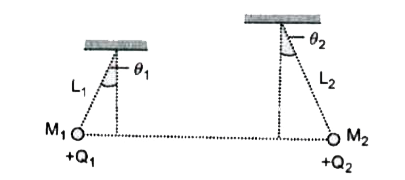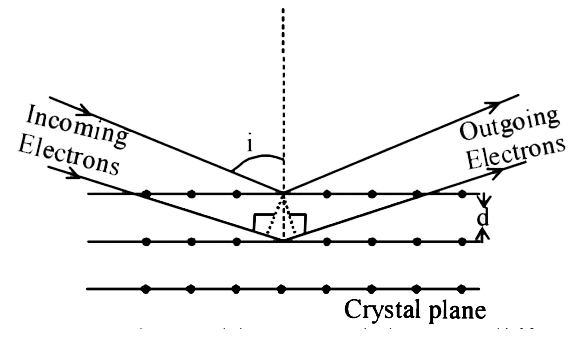Direction : Question Numbers. 150 and 151 are based on the following paragraph.
Wave property of electrons implies that they will show diffraction effects. Davisson and Germer demonstrated this by diffracting electrons from crystals. The law governing the diffraction from a crystal is obtained by requiring that electron waves reflected from the planes of atoms in a crystal interfere constructively (See figure).

Electrons accelerate by potential V are diffracted from a crystal. If d=1Å and i=30∘, V should be about (h=6.6×10−34Js,me=9.1×10−31kg,e=1.6×10−19C)Solution in Kannada
1000 V
2000 V
50 V
500 V
The correct Answer is:C
According to Bragg.s law
2dsinθ=nλ
∴ for first order diffraction,
2dsin(90∘−30∘)=λ
λ=2×1×√32=√3Å
Now λ=h√2meV⇒V=h22meλ2
V=(6.6×10−34)22×9×10−31×1.6×10−19×3×10−20
V=50V
Topper's Solved these Questions
- ELECTRONS & PHOTONSBOOK - MODERN PUBLICATIONCHAPTER - ELECTRONS & PHOTONSEXERCISE - MULTIPLE CHOICE QUESTIONS (LEVEL-III)
9 Videos
- ELECTRONS & PHOTONSBOOK - MODERN PUBLICATIONCHAPTER - ELECTRONS & PHOTONSEXERCISE - RECENT COMPETITIVE QUESTIONS
20 Videos
- ELECTRONS & PHOTONSBOOK - MODERN PUBLICATIONCHAPTER - ELECTRONS & PHOTONSEXERCISE - RECENT COMPETITIVE QUESTIONS
20 Videos
- ELECTROMAGNETIC WAVESBOOK - MODERN PUBLICATIONCHAPTER - ELECTROMAGNETIC WAVESEXERCISE - RECENT COMPETITIVE QUESTIONS
4 Videos
- ELECTROSTATICSBOOK - MODERN PUBLICATIONCHAPTER - ELECTROSTATICSEXERCISE - RECENT COMPETITIVE QUESTIONS
39 Videos
Similar Questions
Energy required for the electron excitation in Li++ from the first to the third Bohr orbit is :
View SolutionAccording to Einstein's photoelectric equation the graph of K.E. of the photoelectron emitted from the metal versus the frequency of the incident radiation gives a straight line graph whose slope
View SolutionAccording to Einstein's photoelectric equation the graph of K.E. of the photoelectron emitted from the metal versus the frequency of the incident radiation gives a straight line graph whose slope
View SolutionThe speed of electromagnetic wave in vacuum depends upon the source of radiation
View SolutionTwo small spheres of masses M1andM2 are suspended by weightless insulating threads of lengths L1andL2 The spheres carry charges Q1andq2 respectively . The spheres are suspended such that they are in level with one another and the threads are inclined to the vertical at angles of θ1andθ2 as shown . Which one o fthe following conditions , if θ1=θ2 ?

View SolutionWave property of electron implies that they will show diffraction effected . Davisson and Germer demonstrated this by diffracting electron from crystals . The law governing the diffraction from a crystals is obtained by requiring that electron waves reflected from the planes of atoms in a crystal inter fere constructiely Electron accelerated by potential V are diffracted from a crystal if d = 1 Å and i = 30^(@), V should be about (h = 6.6 xx 10^(-34) Js, m_(e) = 9.1 xx 10^(-31) kg , e = 1.6 xx 10^(-19)C)
View SolutionWave property of electron implies that they will show diffraction effected . Davisson and Germer demonstrated this by diffracting electron from crystals . The law governing the diffraction from a crystals is obtained by requiring that electron waves reflected from the planes of atoms in a crystal inter fere constructiely

If a strong diffraction peak is observed when electrons are incident at an angle i from the normal to the crystal planes with distance d between them (see fig) de Brogle wavelength λdB of electrons can be calculated by the relationship (n is an intenger)
View SolutionWave property of electrons implies that they will show diffraction effects. Davission and Germer demonstrated this by diffracting electrons from crystals. The law governing the diffraction from a crystal is obtained by requiring that electron waves reflected from the planes of atoms in a crystal interfere constructively (see figure) In an experiment, electrons are made to pass through a narrow slit of width 'd' comparable to either de-Broglie wavelength. They are detected on a screen at a distance 'D' from the slit The following graphs that can be expected to represent the number of electrons 'N' detected as a function of the detector position 'y' ( y=0 corresponds to the middle of the slit) is
View SolutionWave property of electrons implies that they will show diffraction effects. Davission and Germer demonstrated this by diffracting electrons from crystals. The law governing the diffraction from a crystal is obtained by requiring that electron waves reflected from the planes of atoms in a crystal interfere constructively (see figure) The surface of a metal is illuminated with the light of 400 nm . The kinetic energy of the ejected photoelectrons was found to be 1.68 eV . The work function of the metal is : ( hc = 1240 eV-nm )
View SolutionDraw a neat labelled diagram for Davisson and Germer experiment, for diffraction of electron wave.
View SolutionIn Davisson and Germer experiment, a crystal which diffracts a beam of electrons is of
View SolutionDirection : Question Numbers. 150 and 151 are based on the following paragraph. Wave property of electrons implies that they will show diffraction effects. Davisson and Germer demonstrated this by diffracting electrons from crystals. The law governing the diffraction from a crystal is obtained by requiring that electron waves reflected from the planes of atoms in a crystal interfere constructively (See figure). If a strong diffraction peak is observed when electrons are incident at an angle i from the normal to the crystal planes with distance d between them (see tigure), de-Broglie wavelength lamda_(dB) of electrons can be calculated by the relationship (n is an integer)
View SolutionThe wave property of electrons implies that they will exhibit diffraction effects. Davison and Zermer demonstrated this by diffraction of electrons from Christlow. The regulatory law of diffraction from a crystal is derived from the rich interference of the reflected electron waves from the plane of the atoms in the crystal. With the help of the above, choose the most appropriate answer to the following questions. Electrons accelerated by the V potential are reversed from the crystal. If d = 1Å and i = 30^(@) So V should be around this much (h = 6.6 xx10^(-34) J s , m = 9.1 xx10^(-31) kg , e = 1.6 xx10^(19) C)
View SolutionThe wave property of electrons implies that they will exhibit diffraction effects. Davison and Zermer demonstrated this by diffraction of electrons from Christlow. The regulatory law of diffraction from a crystal is derived from the rich interference of the reflected electron waves from the plane of the atoms in the crystal. With the help of the above, choose the most appropriate answer to the following questions. If a strong diffraction peak is seen when the electrons are on the crystal bottom, between which the distance d is incident with the wavelength, then the de Broglie wavelength of the electrons is de Broglie. lambda _(dB) Can be deduced from this equation (n is an integer)
View SolutionWave property of electron implies that they will show diffraction effected . Davisson and Germer demonstrated this by diffracting electron from crystals . The law governing the diffraction from a crystals is obtained by requiring that electron waves reflected from the planes of atoms in a crystal interfere constructiely

Electron accelerated by potential V are diffracted from a crystal if d=1Åandi=30∘,V should be about (h=6.6×10−34Js,me=9.1×10−31kg,e=1.6×10−19C)
View Solution
